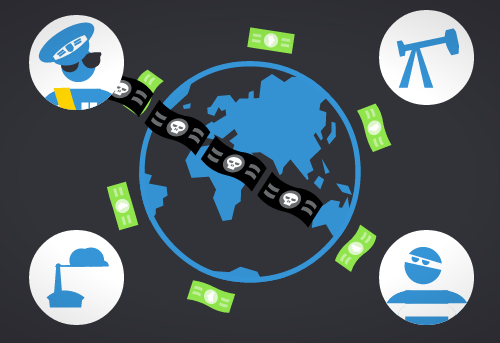 From Transparency International‘s Financial Jargon Buster: Illicit Financial Flows.
From Transparency International‘s Financial Jargon Buster: Illicit Financial Flows.
Grateful thanks to Lucy Chambers for the thoughtful feedback provided on this post.
When we talk about financial transparency, numbers and data are understandably what first comes to mind. But are the platforms and portals collecting all that, the real starting point of our work? And how can we make sure that a particular technology which proved successful for a project whose execution we admire, would actually fit the ecosystem we’re working with?
Sounds like our starting point before kicking off any project should actually be much more lo-fi and hands-on: an offline analysis combining our learnings from the most remarkable case studies with a well-tailored and flexible understanding of the context we’re working with.
The interest in exploring a possible answer to this need got Jean Brice Tetka (Transparency International), Jay Bhalla (Open Institute) and me together in a breakout session during the recent Follow The Money workshop.
After an initial brainstorming in which we thought about project design templates and checklists we knew, which could have been an effective support to plan a financial transparency project, we had the feeling that nothing really matched the characteristics of what we were looking for: something which could be both a shareable template that can cater to a variety of practitioners’ needs, and a flexible tool which can adapt to fit any context we might be working with.
Helpful templates and flexible tools
We wanted it to be shareable and based on a fixed template, because our wish was to have a simple tool which anyone involved in the Follow The Money network could use and benefit from in her/his work.
And it also needed to be flexible, because following the money in a specific social, economical and political context, while at the same time considering the influence of a variety of external and internal actors, is a challenge surely presenting itself differently in any single project – so our tool needed to be responsive to any possible scenario.
Role-playing gaming (!) is what came to our mind as a possible method to design what we needed, and agreed to dedicate our hour together to figure out how we could actually build such a tool.
A role-playing game to build your financial transparency strategy: why and how?
First of all: what do we mean by role-playing game? A role-playing game, in Wikipedia’s words, can be defined as “a game in which players assume the roles of characters in a fictional setting. Players take responsibility for acting out these roles within a narrative, either through literal acting or through a process of structured decision-making or character development. Actions taken within many games succeed or fail according to a formal system of rules and guidelines.”
What we imagined was to create a gaming framework consisting of a few core elements and steps to go through. The framework (the template which any practitioner could adopt in her/ his work) would help to create a fictional environment resembling the context we’re working with, populated by the actors participating in its financial system (a governor, a data analyst, a banker, a citizen, etc.), interacting with each other. Once the fictional setting and the profiles of the actors will be shaped out, the practitioner will have all the (knowledge needed and the) elements to simulate and follow the financial flows, with complete flexibility to best resemble the ecosystem to be analysed.
The game would be useful as
- exercise to provide strengthened and (even if fictionally) trained knowledge of the context of work, its roles, and rules – all essential aspects to be strongly aware of during the project planning phase, from its very beginning;
- method to help avoiding the waste of time which often is experienced when tools are created without a deep analysis of what’s the ecosystem we’re working with and its real needs (not the ones we make assumptions on);
- framework to design action plans, research layouts, tech tools;
- knowledge-sharing platform – the information collected during the execution of the game could be documented and shared as case studies on a diversity of scenarios.
 From Transparency International‘s Financial Jargon Buster: Politically Exposed Person.
From Transparency International‘s Financial Jargon Buster: Politically Exposed Person.
Starting to design the game
The time at our disposal for this conversation was running, so we decided to make the most of it focusing on outlining which would be the core elements of the game. They are:
- Ecosystem
- Actors
- Rules of the ecosystem
- Goals
- Challenges that are stopping us from reaching our goals
Having clear knowledge of how each of them works in our context of choice and playing a game based on them (assuming the roles of the actors involved and taking responsibility for acting out these roles following the rules given by the context) is what we think would constitute a useful, shareable and flexible tool to help anyone design their project plan and workflow.
What do you think?
Now we’d love to keep working on it. We think that concept and core components are all there, but we’d like to flesh out each of the five elements with the collaboration of practitioners with variety of backgrounds and experiences working on financial transparency, and test out its efficiency on some case studies.
Are you interested in getting involved with this project? Would you see this being helpful in your work or do you know of any other similar tool or method?
Please feel welcome to leave a comment below – we’ll be glad to hear your thoughts and feedback and keep building this together.
One thought on “How to design a financial transparency strategy with a role-playing game”